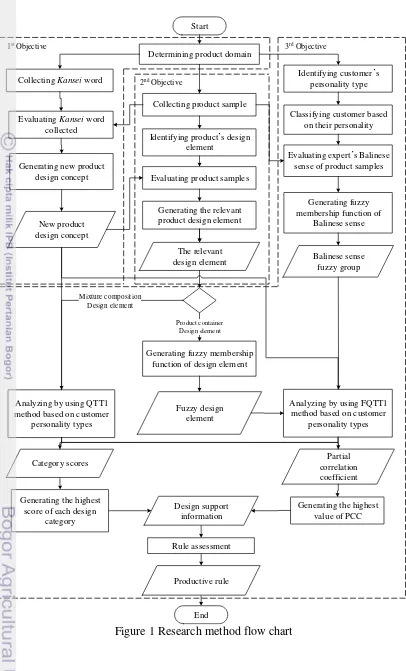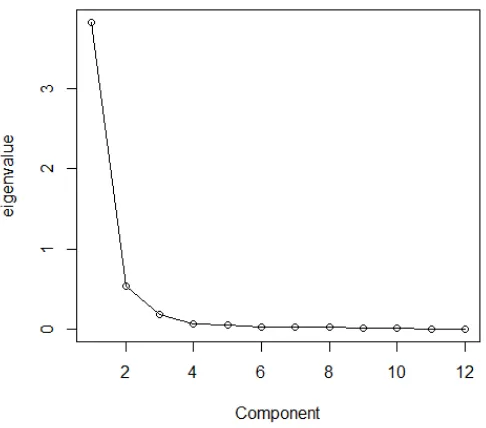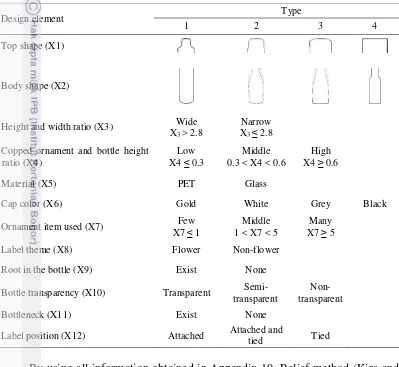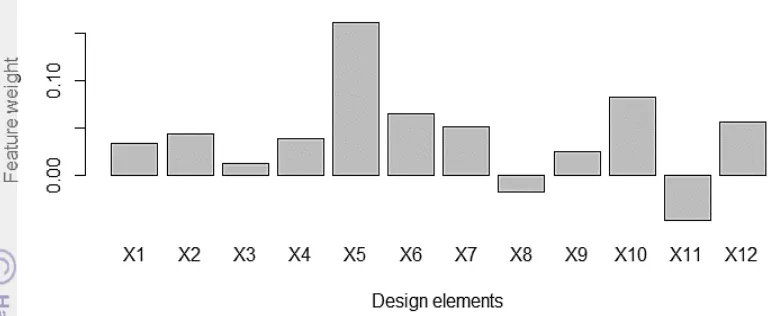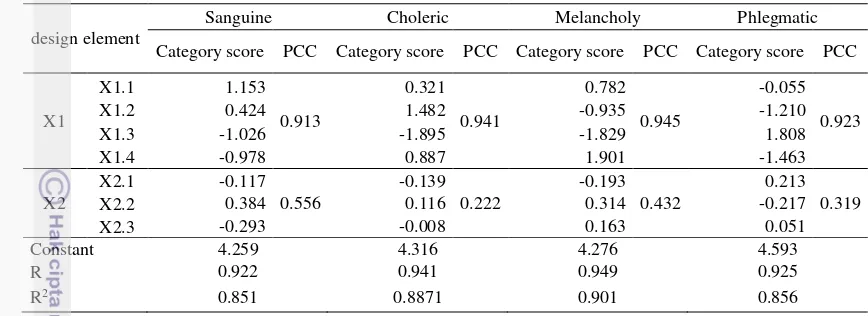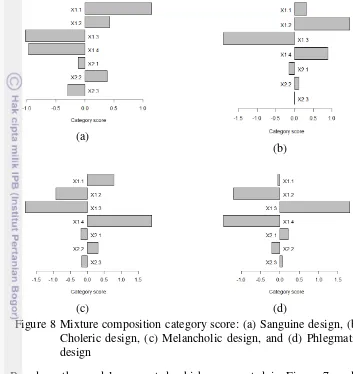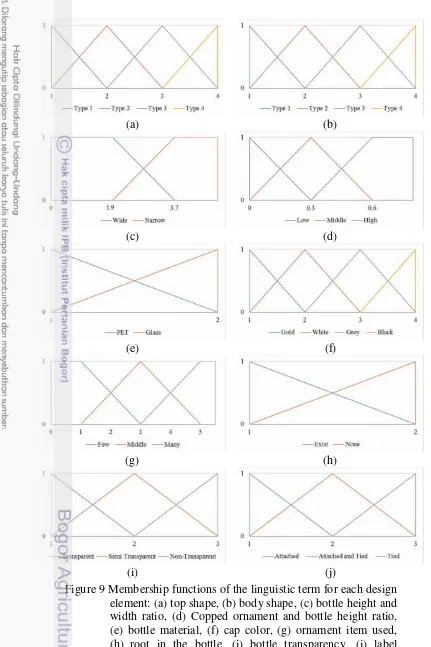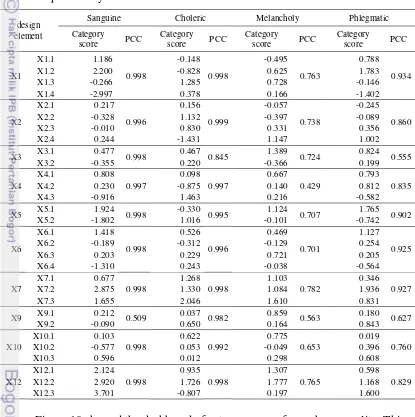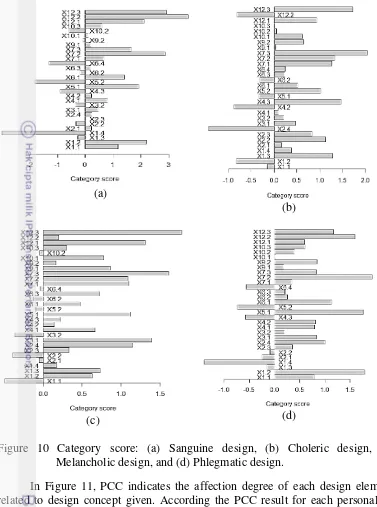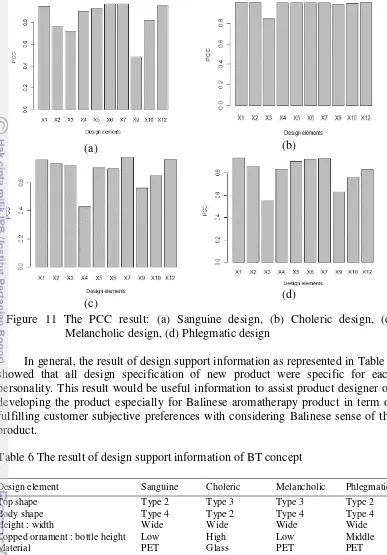BALINESE AROMATHERAPY PRODUCT DEVELOPMENT
BASED ON KANSEI ENGINEERING AND CUSTOMER
PERSONALITY TYPE
IDA BAGUS DHARMA YOGA SANTOSA
GRADUATE SCHOOL
BOGOR AGRICULTURAL UNIVERSITY BOGOR
DECLARATION OF ORIGINALITY
AND COPYRIGHT TRANSFER*
Hereby, I declare that the thesis entitled Balinese Aromatherapy Product Development Based on Kansei Engineering and Customer Personality Type is my own work under supervision of Dr Eng Taufik Djatna, STP, MSi and Dr Ir Luh Putu Wrasiati, MP. It has never previously been published in any university. All of incorporated originated references from other published as well as unpublished papers are stated clearly in the text as well as in the references.
Hereby, I delegate that the copyright to this paper is transferred to Bogor Agricultural University.
RINGKASAN
IDA BAGUS DHARMA YOGA SANTOSA. Pengembangan Desain Produk Aromaterapi Khas Bali Berbasis Kansei Engineering dan Tipe Kepribadian Konsumen. Dibimbing oleh TAUFIK DJATNA dan LUH PUTU WRASIATI.
Produk aromaterapi khas Bali memiliki suatu keunikan lokal yang membuat produk ini unik dan terkenal di pasaran. Pada penelitian ini, pendekatan affective engineering berbasis Kansei Engineering diaplikasikan untuk mengembangkan produk aromaterapi khas Bali. Tipe kepribadian konsumen berdasarkan teori Hippocrates dan Galen digunakan pada proses pengembangan produk ini. berdasarkan motivasi terebut, maka dirumuskan tiga tujuan untuk penelitian ini, antara lain: (1) menghasilkan konsep desain baru untuk mengembangkan produk aromaterapi khas Bali, (2) mengidentifikasi elemen-elemen desain produk yang relevan, dan (3) menghasilkan suatu model kuantifikasi dari desain produk aromaterapi khas Bali.
Terdapat 12 kata Kansei yang telah dikumpulkan dengan mewawancarai para pakar, selanjutnya kata-kata tersebut dievaluasi oleh 30 orang responden menggunakan skala Likert. Metode Principal Component Analysis (PCA) digunakan untuk menganalisis hasil evaluasi tersebut sehingga dapat menghasilkan suatu konsep desain baru. Di sisi lain, dari sampel produk yang telah dikumpulkan, telah teridentifikasi 2 elemen desain untuk komposisi minyak aromaterapi dan 12 elemen desain kemasannya. Berdasarkan hasil tersebut, metode Relief digunakan untuk mengidentifikasi relevansi dari elemen desain tersebut berdasarkan konsep desain yang telah diperoleh. Selanjutnya, Quantification Theory Type 1 (QTT1) digunakan untuk menganalisis hubungan antara konsep desain baru dengan elemen desain yang relevan dan Fuzzy Quantification Type 1 (FQTT1) digunakan untuk menganalisis hubungan tersebut dengan mempertimbangkan kesan keunikan Bali pada produk tersebut sehingga dapat menghasilkan suatu model kuantifikasi dari desain produk aromaterapi khas Bali
Hasil dari metode PCA menunjukkan bahwa terdapat satu komponen utama
yang dapat mewakili keseluruhan komponen yang diberi nama “Bali Tradisional”
(BT). Dengan menggunakan metode Relief, kedua elemen desain komposisi produk dan 10 elemen desain kemasan produk telah teridentifikasi sebagai elemen desain yang relevan dengan konsep BT. Berdasarkan hasil dari QTT1 dan FQTT1, suatu model kuantitatif linear telah dibangun untuk masing-masing tipe kepribadian. Berdasarkan model ini, suatu informasi pendukung desain telah diperoleh untuk membantu desainer produk untuk mengembangkan produk aromaterapi khas Bali. Secara umum, hasil menunjukkan bahwa spesifikasi desain yang diperoleh bersifat spesifik untuk masing-masing kepribadian dan sebagian besar dari desain tersebut bersifat produktif sebagai suatu rule.
SUMMARY
IDA BAGUS DHARMA YOGA SANTOSA. Balinese Aromatherapy Product Design Development Based on Kansei Engineering and Customer Personality Type. Supervised by TAUFIK DJATNA and LUH PUTU WRASIATI.
Balinese aromatherapy products have such local indigenous that make this product unique and famous in the market. In this research, affective engineering approach based on Kansei Engineering is applied to develop Balinese aromatherapy product. Customer personality type based on Hippocrates and Galen theory were involved in the development process. According to its main motivation, three research objectives were formulated (1) to generate the new design concept of Balinese aromatherapy product, (2) to identify the relevant product design element, and (3) to generate the quantification model of aromatherapy product design.
In this research, twelve Kansei words were collected by interviewing the experts and were evaluated by 30 respondents using Likert scale. Principal Component Analysis (PCA) were then used to analyze the result and to generate a new Balinese design concept. On the other hand, from sample products collected, two design element of mixture composition and twelve design elements of product container were identified. From the result, Relief method selected and identified its relevancy to the new design concept. A new design concept, important design elements, and product Balinese sense were then synthesized using Fuzzy Quantification Theory Type 1 (FQTT-1) to generate the quantification model of aromatherapy product design.
The result of PCA method showed that one principal component was generated to represent a new design concept named “Bali Traditional” (BT). By using Relief method, all design element of mixture composition and ten design elements of product container were selected as a relevant design element correspond to BT concept. According to the result of QTT1 and FQTT1, a linear quantitative model has been built for each personality type. From these models, design support information were generated to assist product designers on developing the new Balinese product in both mixture composition and product container. In general, the result showed that all design specification of Balinese aromatherapy product were specific for each personality and most of them were productive as the new design rules.
© Copyright 2015 by IPB
All Rights Reserved
No Part or all of this thesis may be excerpted without or mentioning the sources. Excerption only for research and education use, writing for scientific papers, reporting, critical writing or reviewing of a problem. Excerption doesn’t inflict a financial loss in the paper interest of IPB.
Thesis
as partial fulfillment of the requirements for the degree of Master of Science in the Agroindustrial Technology Study Program
BALINESE AROMATHERAPY PRODUCT DEVELOPMENT
BASED ON KANSEI ENGINEERING AND CUSTOMER
PERSONALITY TYPE
GRADUATE SCHOOL
BOGOR AGRICULTURAL UNIVERSITY BOGOR
2015
Thesis Title : Balinese Aromatherapy Product Development Based on Kansei Engineering and Customer Personality Type
Name : Ida Bagus Dharma Yoga Santosa Student ID : F351130251
Approved by Supervisor
Dr Eng Taufik Djatna, STP, MSi Chair
Dr Ir Luh Putu Wrasiati, MP Member
Acknowledge by
Head of Agroindustrial Technology Study Program
Prof Dr Ir Machfud, MS
Dean of Graduate School
Dr Ir Dahrul Syah, MScAgr
Examination date: July 9th 2015
PREFACE
I would like to thank “Tuhan Yang Maha Esa” for all His gifts so that this research is successfully completed. The theme chosen in the research which conducted starting June 2014 up to February 2015 is Kansei Engineering, with entitled Balinese Aromatherapy Product Development Based on Kansei Engineering and Customer Personality Type.
I would like to express my sincere gratitude to Dr Eng Taufik Djatna as Chairman of Advisory Committee for his support and encouragement during my study in Bogor Agricultural University, to Dr Ir Luh Putu Wrasiati as Member of Advisory Committee for her advice and supervision during the thesis work, and also to Dr Ir Titi Candra Sunarti, M.Si as study program representation and Dr Dwi Setyaningsih, STP, MSi as external examiner for their advice during thesis examination. Additionally, I would like to thank Direktorat Pendidikan Tinggi (Dikti) as a sponsorship of my magister study. Then, I would like to say many thanks to I Wayan Sukhana, Ida Ayu Putu Surya Esti Penida, and Kadek Eka Citrawati as the experts of this research for their advice, support, and encouragement in this research.
I would like to say many thanks to my family, my father IB Surya Manuaba, my mother Annie M Goller, my sister IA Ratih Stefani, and my closest friend NLPE Kartika Sari for their true and endless love for never failing patience and encouragement. I would like to thank all lecturers and staff of Agroindustrial Technology Department, all of my colleagues, especially my best friend in Agro-industrial Technology (Elfira Febriani, Hety H Hidayat, Novi Purnamasari, Aditia Ginantaka, Nina Hairiyah, Nova Alemina Sitepu, and Elfa S Thamrin), colleagues in Computer Laboratory of Agro-industrial Technology Department (Iwan Aang, Zaki Hadi, Riva Aktivia, Rahmawati, Azri Firwan, Rohmah, Fajar Munichputranto, Husnul Khotimah, Puspa, Aisyah, Yudhis, Ihsan, Imam, Denny), all of colleagues in Agro-industrial Technology 2013 and 2014, and my colleagues in KMHD (Joni A Wiranata, Manu Mahatmayana, Perdana Kumara, Giri Putera, Didi Harizena, Pratyaksa Yudha, AA Keswari Krisnandika, Nengah Putri Adnyani, Siluh Putu Dia, etc), for their support. It has been a pleasure to work and sharing with you.
Hopefully this thesis is useful.
TABLE OF CONTENT
TABLE LIST vii
FIGURE LIST vii
APPENDIX LIST viii
1 INTRODUCTION 1
Background 1
Problems Statement 2
Objectives 3
Benefits 3
Boundaries 3
2 RELATED WORK 3
3 METHOD 4
Research Period and Location 4
Research Framework 4
Design Concept of Balinese Aromatherapy Product 6
Balinese Aromatherapy Product Design Element 6
Quantification Model of Balinese Aromatherapy Product 6
Data Analysis 7
Principal Component Analysis 7
Relief 7
Quantification Theory Type I 8
Fuzzy Quantification Theory Type 1 9
Fisher Exact Test 11
4 RESULT AND DISSCUSSION 11
Design Concept of Balinese Aromatherapy Product 11
Product domain determination 11
Design concept generation 12
Balinese Aromatherapy Product Design Element 14
Design element of mixture composition 14
Design element of product container 15
Quantification Model of Balinese Aromatherapy Product 17
Personality type of respondent 17
Product Balinese sense fuzzification 18
Quantification model of mixture composition 18
Quantification model of product container 21
Rule assessment 26
Advantage and Disadvantage 27
5 CONCLUSION AND RECOMMENDATION 27
Conclusion 27
Recommendation 27
TABLE LIST
1 Identification of product mixture composition 14
2 The result of design element identification 16
3 Formulation of aromatherapy product mixture composition based on
customer personality 19
4 Design support information for the aromatherapy product design based
on customer personality 20
5 Formulation of aromatherapy product container based on customer
personality 23
6 The result of design support information of BT concept 25 7 The result of Fisher exact test of product mixture composition 26 8 The result of Fisher exact test of product container 26
FIGURE LIST
1 Research method flow chart 5
2 The result of eigenvalue 13
3 Variables factor map (PCA) 13
4 The Relief result of product mixture composition 15
5 The Relief result of product container 17
6 The proportion of personality type of respondent 18
7 The PCC result of product mixture composition 19
8 Mixture composition category score: (a) Sanguine design, (b) Choleric design, (c) Melancholic design, and (d) Phlegmatic design 20 9 Membership functions of the linguistic term for each design element: (a)
top shape, (b) body shape, (c) bottle height and width ratio, (d) Copped ornament and bottle height ratio, (e) bottle material, (f) cap color, (g) ornament item used, (h) root in the bottle, (i) bottle transparency, (j)
label position. 22
10 Category score: (a) Sanguine design, (b) Choleric design, (c)
Melancholic design, and (d) Phlegmatic design. 24
11 The PCC result: (a) Sanguine design, (b) Choleric design, (c)
APPENDIX LIST
1 Product domain and Kansei words identification questionnaire 30
2 Product sample collection 33
3 Kansei words evaluation questionnaire 38
4 Personality type identification and new design concept evaluation
questionnaire 44
5 Product Balinese sense evaluation questionnaire 53
6 The result of product domain identification 55
7 The result of KW evaluation 60
8 The result of PCA 62
9 The result of product mixture composition classification and
evaluation (hypothetical data) 63
10 The result of product container classification and evaluation 64
11 The result of Relief 66
12 The result of customer personality type identification 67 13 The result of product mixture composition evaluation (hypothetical
data) 68
1
INTRODUCTION
Background
Balinese aromatherapy products, such as aromatherapy scrub, incense, massage oil, soap, and many more have such uniqueness which has a big contribution to make the product become famous in the market (Archam et al. 2013). Moreover these products were coped high value of business since Bali has
chosen as “The Best Spa Destination of The World in 2009” on SENSE Magazine
version (Dispar 2010). In addition, from 2009 to 2013, about 2 803 181 visitors came to Bali with 9.5% increased for each year (BPS 2014). Considering this condition, in order to winning the competition in this sector, the need of the development of aromatherapy product has always been a challenge as well as the changing of customer demands and expectations.
Currently, Balinese aromatherapy product still applied conventional method in its product development which beginning from product designer who proposed the product design, decision maker who decided whether the design accepted or not, until manufacturing unit to produce the product based on its design. This conventional method has several disadvantages especially when dealing with the multidesign product such as Balinese aromatherapy massage oils. These limitations occurred in such condition (Ko 2010) as right idea rarely comes at the right moment, the result depends strongly on individual talent and experiences, and the solution will be limited by one’s special training and experience.
In order to cope these limitations, affective engineering approach based on Kansei Engineering (KE) was proposed in this research as the improvement of current conventional method. KE is a product development method that translates customer impression such as like or dislike, good or bad, and so on (Peter and Oalson 2005) into product design specification (Nagamachi 2011). By using KE as a product development method is expected to stimulate the idea generation of product designer so the result is not depends on individual talent and experiences anymore. Eventually, the design solution will not limited by one’s special training and experience anymore because there are customer impression that involved in the design.
On the previous research, KE has been applied on the development of the many design products, such as wine glass design (Petiot and Yannou 2004), rocker switch design (Scutte and Eklund 2005), fragrance packaging design (Wei et al. 2011), automobile head-up display (Smith and Fu 2011), shampoo packaging design (Archam et al. 2013), and aromatherapy mixture composition (Djatna and Santosa 2014). In this research, KE was applied on Balinese aromatherapy product development by identifying customer needs implicitly and relates them to product design specification (Lokman 2010).
(2014) in order to deal with this condition, customer personality type was proposed to involve in the product development method. This solution is also supported by Jordan (2000) who said that each customer has particular criteria on which they want to buy related to their personality, for instance generally, extrovert customers prefer gold color than black or grey.
The research challenges in aromatherapy product design are consisted of two main parts which about how to construct aromatherapy mixture composition and its container. Refer to Djatna and Santosa (2014), it is proposed Quantification Theory Type 1 (QTT1) method to formulate the quantification model of aromatherapy mixture composition. In this research, the quantification model of aromatherapy mixture composition was generated as a result of analysis of the relationship between customer impression related to design concept given and product design elements related to aromatherapy product mixture composition.
Another challenge is about how to develop Balinese aromatherapy product container while preventing its uniqueness aspect. With considering Balinese sense of the product as the uniqueness aspect, Fuzzy Quantification Theory Type 1 (FQTT1) is proposed to quantify the design of Balinese aromatherapy product container. By using FQTT1, quantification model were generated from the result of relationship between customer impression related to design concept given and product container design elements with considering Balinese sense of the product. By using these model generated from both QTT1 and FQTT1 analysis, the recommendation about combination of the design elements on both mixture composition and container were obtained directly for each customer personality type. This recommendation is expected to be the usefull information that able to assist product designer to develop the Balinese aromatherapy product in order to fulfill customer subjective preferences.
Problems Statement
It is always been a big challenge for product designer to develop the product continuously as well as the changing of customer requirement and preference. In order to assist product designer to develop the product, KE was chosen as a product development method which involving customer impression on its process. Moreover customer personality type were involved to pursue the pleasurable design which reflecting their own personality. Thus, there were several problems related to Balinese aromatherapy product development based on KE and customer personality type, as follows:
1. How to generate the design concept of Balinese aromatherapy product based on its customer impression?
2. How to identify the product design elements which are relevant for the new design concept generation?
Objectives
Based on described proposed problem above, there are three main objectives formulated in this research as follows:
1. To generate the design concept of Balinese aromatherapy product 2. To identify the relevant product design elements
3. To generate the quantification model of Balinese aromatherapy product design
Benefits
The research is expected to give three benefits which consist of to provide the information related to the new design concept generation, product design element which relevant to its design concept, and quantification model of Balinese aromatherapy product design. Moreover, the result of this research is expected to give the recommendation about combination of the product design elements for each customer personality type. This would be useful information to assist product designer to develop the Balinese aromatherapy product in order to fulfill customer subjective preferences.
Boundaries
In order to concentrate for solution, there were several boundaries in this research as follow:
1. This research was conducted in Bali, so does the sample collected and respondent involved
2. Balinese aromatherapy massage oil was chosen as the object of this research 3. The quantification model of aromatherapy mixture composition were
generated from QTT-1 analysis by using hypothetical data
4. The quantification model of aromatherapy product container were generated from FQTT-1 analysis by using survey data
2
RELATED WORK
For years, KE has been applied on the development of the many product design, such as wine glass design (Petiot and Yannou 2004), rocker switch design (Scutte and Eklund 2005), fragrance packaging design (Wei et al. 2011), automobile head-up display (Smith and Fu 2011), and mixture composition of aromatherapy product (Djatna and Santosa 2014). These four research have been used Quantification Theory Type 1 (QTT-1) to synthesize the Kansei design concept and product design element.
design element and the level of design element affection refers to customer subjective preference. In this research QTT-1 method were used to generate the quantification model of aromatherapy product mixture composition for each personality type.
Additionally, Fuzzy Quantification Theory Type 1 (FQTT-1) were used to synthesize three dimensions of Kansei which consisted of Kansei design concept, design element, and Balinese sense of the product. Additionally, design element fuzzy group were deployed to generate the membership degree of each variance of design element which is ranged between zero to one. Involving the membership degree of both design element and product Balinese sense is expected to obtain the better result of the new design model generation for each personality type.
Based on the model generated from both QTT-1 and FQTT-1 method, the new design combination were generated which is represented by linear model approach. From the result, a design support information would be proposed to give the recommendation about optimum design element combination of the Balinese design directly based on customer personality type. This would be useful information for product designer to develop the product especially for Bali aromatherapy product for each customer personality type in order to minimize the risk of the failure of the product design in the market.
3
METHOD
Research Period and Location
This research was conducted from June 2014 to February 2015. The sample products were collected in both modern and traditional market in Bali from July to August 2014. The survey activities were conducted at Sensory Laboratory of Agro-industrial Technology, Udayana University, Jimbaran. Thus, data analysis were conducted at Computer Laboratory of Agro-industrial Technology, Bogor Agricultural University, Bogor.
Research Framework
The research framework was designed in parallel form to solve the problem which beginning from problem definition, research objectives, methodology, result discussion, and conclusion. The methodology was designed to accomplish the research objectives. In this research, R language version 3.1.3 (Ihaka and Gentleman 2015) was used as a tool of data processing. The framework detail and process of the research method is represented in Figure 1.
Start
Determining product domain
Classifying customer based on their personality Evaluating Kansei word
collected
Generating new product design concept
Collecting product sample
Identifying product’s design element New product design concept The relevant design element End Collecting Kansei word
Generating the relevant product design element
Identifying customer’s personality type
Evaluating product samples
Analyzing by using FQTT1 method based on customer
personality types Evaluating expert’s Balinese
sense of product samples
Balinese sense fuzzy group
Rule assessment
Category scores correlation Partial
coefficient
Generating the highest score of each design
category
Generating the highest value of PCC Design support
information
Generating fuzzy membership function of
Balinese sense
Generating fuzzy membership function of design element
Fuzzy design element
Productive rule Analyzing by using QTT1
method based on customer personality types
Product container Design element Mixture composition
Design element
Figure 1 Research method flow chart 1st Objective
2nd Objective
Three experts and thirty customers of aromatherapy product were involved in this research. The experts involved are the owner of Balinese aromatherapy product and have over ten years of experience in aromatherapy product business. The respondents were selected as a result of purposive sampling with several criteria as follows: (1) they have known the product, (2) they have seen the product, (3) they have used the product, and (4) they will buy the product. Thus, the evaluation step was conducted by using Likert scale with seven scale.
Design Concept of Balinese Aromatherapy Product
The research method began with the identification of product domain as the research object. Afterward, the Kansei words (KW) were collected by interviewing three experts. In this phase, a questionnaire (see Appendix 1) was given to the experts which aimed to determine the product domain and to collect the Kansei words. From the result of product domain determination, total amount 25 various samples of Balinese aromatherapy product have been collected from both traditional and modern market in Bali (see Appendix 2). With involving 30 respondents, the product samples collected and the collection of Kansei words was then evaluated by using second questionnaire (see Appendix 3). The evaluation result was then analyzed using Principal Component Analysis to generate a new Balinese aromatherapy design concept as well as to achieve the first objective of this research.
Balinese Aromatherapy Product Design Element
In order to achieve the second objective of this research, product design elements of both mixture composition and product container were identified from each sample collected. The product samples collected was then evaluated according to the new design concept generated by using the third questionnaire (see Appendix 4). Thus, the result was analyzed using Relief method to obtain which design elements are relevant to the new design concept generated.
Quantification Model of Balinese Aromatherapy Product
Thus, in order to accomplish the third research objective, firstly, the personality test of respondent was evaluated using questionnaire as seen in Appendix 4 (Littauer 1996). Afterward, quantification model of aromatherapy mixture composition was generated as a result of analysis of the new design concept and the product design elements. On the other hand, the level of Balinese sense of the product was then evaluated by the experts using a questionnaire as seen in Appendix 5. A quantification model of aromatherapy product container was generated after fuzzification step was perform on both design elements and product Balinese sense. Finally, the optimum product container design was generated as a result of the relationship of new design concept and product design elements with considered product Balinese sense for each customer personality type.
would be evaluated using Fisher Exact Test in order to produce the productive rules of new Balinese aromatherapy design for each customer personality type.
Data Analysis
Principal Component Analysis
Principal Component Analysis (PCA) is a powerful tool of feature extraction which could reduce the dimensional data without losing much information (Bouzalmat et al. 2014). In this research, PCA were used to reduce the dimension of KW collected and followed by generating a new concept of product design (Nagamachi 2011). To deploy PCA in this research, firstly, defines X as a matrix of KW evaluation for p dimensions of KW which denotes as X = {x1, x2, …, xp}Corr where xi€ X. Then calculates the mean (μi) of X for n product sample (i = 1, 2,…, n) as in (1) which denotes as M = {μ1, μ2,…, μp}.
1
1
ni i
i
x
n
(1)The next step is to calculate the subtract matrix between X and M as in (2) which denotes as Y = {y1, y2,…, yp}.
i i i
y
x
(2)Afterward, in order to see the correlation between KW, compute the covariance of matrix of Y which denotes as C with p x p dimensions as in (3).
C = 1 ( -1)n Y
T * Y (3)
Generate eigenvalue and eigenvector of C as formulated in (4) where eigenvector denotes as B = {b1, b2,…, bp} and eigenvalue denotes as λ = {a1, a2,…, ap}.
C * B = λ * B (4)
According the result of eigenvalue λ, determine how many principal component (PC) should be retained. Generally the PC which has eigenvalue above 1 were retained. Finally, Group the KW into their PC according to their loading components which are generated from matrix eigenvector B and the new design concept is then obtained from the interpretation of KW within PC obtained.
Relief
1996). The equation of Relief is represented as in (5). In the equation, first, defines ith feature (design element) as fi where F = {f1, f2,..., fm}, the weight of the
ith feature as wfi where W = {wf1, wf2,…,wfm}, and the number of each feature data
record for m dimensional features (i= 1, 2,…,m) and n sample size (t = 1, 2,…, n) which denotes as xti where X = {xt1, xt2,…, xtm}.
( 1)
2
1 ( 1)
( , )
(
1)
i
n n
t j t j t
f
diff x y
w
n
(5)Generally, Relief equation above runs using pairwise between data record (xt
and yj) where xt indicates an instance of feature data record and yj indicates an
instance neighbor of xt. In equation above, function diff (xt, yj)2 is calculated as in
(6), where rfi is a range unit of ith feature attribute to normalize the values of the
function into the interval [0, 1].
2
2
2
+ (if and are the different class)
( , )
(if and are the same class) i i t j t j f t j t j t j f x y x y r diff x y
x y x y r (6)
As in (6), if pairwise between xt and yj are in the same class, then the value
of function diff is negative. Otherwise, function diff will have a positive value when xt and yj are in a different class. In this research, Relief method was used to
figure out the relevant design element of a product for the new Balinese aromatherapy design concept.
Quantification Theory Type I
QTT-1 method considered as a qualitative and categorical multiple regression analysis method, which allowed inclusion of independent variables that are categorical and qualitative in nature, such as product design elements and quantitative criterion variables within KE (Wei et al. 2011). In QTT-1 method, the relational model associated with the measured score of experimental sample and customer preferences is defined. Thus, the categorical multiple regression model is defined as in (7):
1 1 i C E k ij ijs s i j
y
x
(7)As in (7), ̂� expresses the predicted value of customer impression for the sth product sample (s = 1, 2,…, n) on corresponding kth design concept. The index of design element is denoted by i where i = (1, 2,…, E) and the number of design element is denoted by E. The index of design category is denoted by j where j = (1,
Additionally, � indicates the category score of the jth style within the ithdesign element, � denotes the coefficient of the dummy variable which has binary number value [0, 1] and � expresses a stochastic variable whose expectation value E(�) = 0.
2 2 2 2 2
((
)(
))
(
)
(
) (
)
r
Y,Y
Y-Y Y-Y
Y-Y Y-Y
(8)The principle for quantification is to find the combination of category score which maximizing the sample correlation coefficient (ρ) between observed value (Y) where Y= {y1, y2,…, yn} and predicted value (�̂) where �̂ = {̂ , ̂ , … , ̂�}.
The correlation coefficient between observed and predicted value is represented as in (8) where �̅ indicates the average of observed value and �̂̅ indicates the average of predicted value. In this research, QTT-1 is proposed to figure out the optimum linear combination of aromatherapy product mixture composition for each personality type.
Fuzzy Quantification Theory Type 1
Fuzzy Quantification Theory Type 1 (FQTT-1) is a qualitative regression analysis method that aims to analyze the relationship between qualitative descriptive variables which are given in values on [0, 1] and numerical object variables in the fuzzy groups given in the sample (Terano et al. 1987). FQTT-1 model as represented in (9) means a linear function of categories that best expresses the structure of the data by minimizing the object variation given and its error variance (Terano et al. 1987).
1
( )
( )
K
i i i
y
a
(9)In model above, y(ω) expresses the objective function of ω th sample and μ
i
(ω) is the degree of response to ith qualitative category (i = 1, 2,…, K), which has values on [0, 1]. The category weight (a) that minimizes the error variance is given by the following equation (Terano et al. 1987) as in (10).
A = (XTGX)-1 XTGY (10)
In equation (10), matrix A denotes a set of K category weights, where A = {a1, a2,… , aK}. Matrix X contains groups of qualitative categories of n sample
given which denotes as X = {μi (1), μi (2),…, μi (n)}. Matrix G is a diagonal matrix
of fuzzy group B (μB (ω)) that expresses the fuzzy set of n sample given as
denotes in G = diag (μB (1), μB (2),…,μB (n)). Finally, the objective functions of n
sample given is contained in matrix Y which is defined as Y = {y (1), y (2),…, y (n)}.
fuzzy PCC, first calculate fuzzy means and fuzzy covariances. With considered xi(ω) = aiμi(ω), fuzzy means for ith category ( ̅ ) and objective variable (̅) are
calculated as in (11) and (12). The next step in to calculate fuzzy covariances (σ) as seen in (13), (14), and (15).
1 1
1
( ) ( )
M ni i B
r
x
x
N
(11)1 1
1
( ) ( )
M n B ry
y
N
(12)1 1
1
( ( )
)( ( )
) ( )
M n
i j
ij i j B
r
x
x x
x
N
(13)1 1
1
( ( )
)(y( )
) ( )
M n
i
iy i B
r
x
x
y
N
(14)2
1 1
1
(y( )
)
( )
M n yy B r
y
N
(15)Using these covariances, matrix of fuzzy correlation coefficient is generated which is denoted as R with i x j dimension where R = {r11, r12, …, rij, r1K, riy} and i = j = 1, 2, …, K. The formulation of fuzzy correlation coefficients rij
and riy are represented as in (16) and (17). ij ij ii jj
r
(16) iy iy ii yy r
(17)The invers of matrix Ris then calculated which is denoted as R-1 = {r11, r12,…,rij, r1K, riy}. Using this matrix R-1, The fuzzy PCC which is denoted as riy: 1, 2, …, i-1, i+1, …, K are defned as in (18).
:1,2,..., 1, 1,...,
iy iy i i K ii yy
r
r
r r
(18)Fisher Exact Test
In this research, Fisher exact test were used to assess the rule productivity of design support information generated. In this method, the test directly conducted to show whether the rule R: fi Y is productive or not (Zaki and Meira 2013).
Let consider fi as a feature or design element generated where F = {f1, f2, …, fm}
and Y refers to customer preference which score above 4. The equation of p-value calculation based on fisher exact test is represented as in (19).
(
)! (
)! (
)! (
)!
! ! ! ! !
a b
c d
a c
b d
p value
n a b c d
(19)In equation above, “a” denotes the value of appearance probability of both fi and Y, “b” denotes the value of appearance probability of fi but not Y, “c” denotes the value of appearance probability of Y but not fi, “d” denotes the value of appearance probability of neither both fi nor Y in dataset given, and “n” denotes the number of record within dataset. Thus, from the result of equation as in (6), the rule is considered as a productive rule when the result of p-value is less or equal than significance threshold given (α).
4
RESULT AND DISSCUSSION
Design Concept of Balinese Aromatherapy Product
Generating the design concept of aromatherapy product is necessary to develop the product which suitable with customer good impression. In this research, design concept was generated from the collection of customer impressions related to Balinese aromatherapy product. PCA method was deployed to analyze the impressions and to acquire the important information lies on customer impression correspond to generate the design concept of Balinese aromatherapy product. In this section, it is discussed about how to determine aromatherapy product domain, and how to generate the design concept from the collection of customer impression.
Product domain determination
Aromatherapy is defined by the Sense of Smell Institute (SSI) as the therapeutic effects of aromas on physical conditions (such as menstrual disorders, digestive problems, etc) as well as psychological conditions (such as chronic depression) (Baser and Buchbauer 2010). There are virtually thousands of aromatherapy products in pharmacies, high street shops, supermarkets, hair salons, and beauty salons. The product are supposedly composed of essential oil (which are usually perfumes) which has an effect on brain via inhalation, skin absorbsion, or even directly via the nose (Baser and Buchbauer 2010).
aroma will bound by reseptors in olfactory bulb. These reseptors will send the signals go through amigdala and limbic system in the brain. These parts of brain have a big contribution related to human memory and emotion (Butje et al. 2008). Olfactory stimulation causes immediate physiological changes in blood pressure, muscle tention, pupil size, blink magnitude, skin temperature, skin blood flow, and arousal states (Kuroda et al. 2005). Inhaled odors activate the release of neurotransmitters such as serotonis, endorphins, and norepinephrine in the hhypotalamic pituitary axis and modulate neuroreceptors in the immune system, altering mood, reducing anxienty, and interrupting the stress response (Shannon 2002).
In this research, Balinese aromatherapy product domain was determined based on expert recommendation. A set of questionnaire (see Appendix 1) was given to three owners of Balinese aromatherapy product manufacture as the experts in this research. The result in this phase showed that Balinese aromatherapy product is an aromatherapy product which made from Bali indigenous flower in Bali. Several Bali indigenous flower which are popular in this business consist of frangipani, champaka, ylang-ylang, and sandalwood.
Additionaly, “the most potential Balinese aromatherapy product to develop” was identified in this phase. The result of product domain identification which represented in Appendix 6 showed that Balinese aromatherapy massage oil is the most potential product to develop due to two main reasons, first, aromatherapy product is closely related with spa which is identical with massage activity and second, aromatherapy massage oil is a multifunction product which can be used as a lotion, burn oil, bath oil, skin nutrition, and massage oil itself. Finally, based on the result of this phase, frangipani, champaka, ylang-ylang, and sandalwood massage oil was chosen as the object of the research.
Design concept generation
In this phase, twelve KW have been collected by means interviewing the experts which illustrated Balinese aromatherapy product. These KW consisted of
“unique”, “attracting”, “exotic”, “natural”, “Baliproduct”, “luxurious”, “artistic”, “bright”, “traditional”, “fashionable”, “eco-friendly”, and “transparent”. Then to generate the new design concept, all the KW collected were evaluated by 30 customers of aromatherapy product. Likert scale (7 scale) were used in this evaluation phase. The result of KW evaluation is represented in Appendix 7.
Figure 2 The result of eigenvalue
Figure 2 showed the result of eigenvalue of each component. The larger eigenvalue shows the more principal component represents the characteristics of the original data. Based on PCA result in Figure 2, first principal component which has eigenvalue above 1 (3.818) was generated to represent the information of all the KW collected. The result showed that the first principal component has 79.51% contribution to describing the characteristic of the original data.
Figure 3 Variables factor map (PCA)
Then the KW were grouped into their principal component as seen in Figure 3. Based on the result of PCA, “Bali Traditional” (BT) was chosen to illustrate the
group of first principal component (“unique”, “attracting”, “exotic”, “natural”, “Balinese product”, “luxurious”, “artistic”, “traditional”, “fashionable”, and “eco
-friendly”) as a new design concept of Balinese aromatherapy product as the
Balinese Aromatherapy Product Design Element
In KE research, product design element has a big contribution to create customer attractiveness (Nagamachi and Lokman 2015). For instance, customers will feel attracted when they see a new product and they will check the product whether it impacts their feelings or not. The main idea is when the customer don’t feel attracted and feel an impact when they touch the product, the opportunity to get touch with customer is not developed and there no chance of the product being purchased. This condition showed that product design elements is essential to give the impression to customers directly (Muharam 2011).
In this research, the design of aromatherapy product was devided into two parts consisted of its mixture composition and its container design. Each of them has particular role on customer buying decision. In this research the aromatherapy product design on both mixture composition and container were decomposed into their design element and followed by classifying the product collected into its design element. In this section, it is discussed about how to identify the product design element on both mixture composition and product container and to evaluate which elements are relevant to the design concept generation.
Design element of mixture composition
The identification of aromatherapy mixture composition was conducted on the sample product collected. There are two main composition which compounded in aromatherapy massage oil which consisted of essential oil and carrier oil. A few drops of essential oil or oils chosen are always mixed with a carrier oil before being applied to the skin for an aromatherapy massage (Baser and Buchbauer 2010). The exact dilution of the essential oils in the carrier oil is often controversial and can be anything from 0.5% to 20% or more (Baser and Buchbauer 2010).
Table 1 Identification of product mixture composition
Type
Mixture composition Essential oil
(X1)
Carrier oil (X2)
1 Frangipani Coconut oil
2 Champaka Olive oil
3 Ylang-ylang Soybean oil
4 Sandalwood
The other result showed that there were three carrier oils (X2) compounded in the product collected, consisted of coconut oil, olive oil, and soybean oil. All the products used vegetable oil as its composition which represented the traditional aspect of Bali indigenous. Carrier oil, also known as fixative oil or base oil, compounds most of the liquid in massage oil. It is used to dilute (carrying) essential oil and all provide a lubricant which many have a high vitamin E and A content (Baser and Buchbauer 2010). After the mixture composition compounded in each product was identified, the product collected were then classified based on its design element, evaluated corresponds to BT concept by 30 respondent, and finnaly analyzed using Relief method. The result of the design element classification and evaluation are represented in Appendix 9.
For instance in Appendix 9, sample 1 has grouped into its design category as follow: “X1=2” and “X2=3”. Refers to Table 1, these result showed that sample 1
has “essential oil: ylang-ylang” and “carrier oil: coconut oil”. The evaluation score of Bali Traditional impression of sample 1 is 2.949. This result is the average score of 30 respondents. Because the result has the score which is smaller than 4, then the sample 1 is classified as NBT (Non Bali Traditional). On the other hand, if the average score of Bali Traditional impression is larger than 4 which showed in sample 2 (5.815), then sample 2 is classified as BT (Bali Traditional).
Figure 4 The Relief result of product mixture composition
All these data in Appendix 9 were analyzed using Relief and the result is represented in Figure 4 and Appendix 11 (a). As seen in Figure 4 and Appendix 11(a), the result of Relief method represented that all design element of mixture composition have shown the weight of attribute importance more than zero which mean these two design elements are relevant related to new concept generated. The result implies that designers should focus on their attention to both aromatherapy essential oil and its carrier oil when the design objective of the product is to achieve a desirable BT concept.
Design element of product container
The result of design element identification phase showed that from 25 product sample collected, there were 12 categories with 34 varians of design elements identified using morphological analysis. The identification result is represented in Table 2. Afterwards, the design element of all gathered products were grouped into their categories, evaluated based on BT concept using Likert scale (7 scale) and classified into two categories as seen in Appendix 10.
For instance in Appendix 10, sample 1 has grouped into its design category as follow: “X1=3”, “X2=1”, “X3=2”, and so on. Refers to Table 2, these result
width ratio: narrow”, and so on. The evaluation score of Bali Traditional impression of sample 1 is 4.267. This result is the average score of 30 respondents. Because the result has the score which is larger than 4, then the sample 1 is classified as BT (Bali Traditional). On the other hand, if the average score of Bali Traditional impression is smaller than 4 which showed in sample 3 (3.767), then sample 3 is classified as NBT (Non Bali Traditional).
[image:30.595.83.482.204.571.2]
Table 2 The result of design element identification of product container
Design element Type
1 2 3 4
Top shape (X1)
Body shape (X2)
Height and width ratio (X3) Wide X3 > 2.8
Narrow X3 ≤ 2.8
Copped ornament and bottle height ratio (X4)
Low X4 ≤ 0.3
Middle 0.3 < X4 < 0.6
High X4 ≥ 0.6
Material (X5) PET Glass
Cap color (X6) Gold White Grey Black
Ornament item used (X7) Few X7 ≤ 1
Middle 1 < X7 < 5
Many X7 ≥ 5
Label theme (X8) Flower Non-flower
Root in the bottle (X9) Exist None
Bottle transparency (X10) Transparent Semi-transparent
Non-transparent
Bottleneck (X11) Exist None
Label position (X12) Attached Attached and
tied Tied
By using all information obtained in Appendix 10, Relief method (Kira and Rendell 1992) was performed using R language to determine which relevant product design elements for BT concept. The design elements (features) are relevance when its weight (wi) is larger than zero (Kira and Rendell 1992). The
Figure 5 The Relief result of product container
According the result, ten design elements which have the weight of attribute importance more than zero were generated as the relevant design elements. These ten design elements consisted of “top shape (X1)”, “body shape (X2)”, “bottle
height and width ratio (X3)”, “copped ornament and bottle height ratio (X4)”, “bottle material (X5)”, “cap color (X6)”, “ornament item used (X7)”, “root in the bottle existence (X9)”, “bottle transparency (X10)”, and “label position (X12)”. The result implies that designers should focus on their attention more to these ten relevant design elements when the design objective of the product is to achieve a desirable BT concept.
Quantification Model of Balinese Aromatherapy Product
In this research QTT-1 method was deployed to analyze the relationship between customer impressions related to BT concept and product mixture composition quantitatively. Meanwhile, FQTT-1 method was deployed on product container with considering Balinese sense of the product in the analysis. Both of them were deployed for each personality type and the design support information was generated from the result of the analysis. In this section, it is discussed about how to identify the personality type of respondent involved, how to obtain the linguistic variables of product Balinese sense, how to generate the quantification model of aromatherapy mixture composition and its container, and finally, how to evaluate the model generated from both QTT-1 and FQTT-1 analysis.
Personality type of respondent
Figure 6 The proportion of personality type of respondent
The result of identification is represented in Appendix 12. From thirty respondents involved, there were identified ten Sanguines, nine Melancholics, three Cholerics, and eight Phlegmatics which involved in this research. The proportion of respondent’s personality type is represented in Figure 6.
Product Balinese sense fuzzification
Balinese sense of product was evaluated by the experts using Likert scale (7 scale). Afterward, the result was then transformed into one category of linguistic
variable “strong”. The “strong” degree product Balinese sense was represented from its fuzzy membership function with one category (μstrong) which ranged from
0 to 1 by using function as seen in (20). As in (20), x refers to the average of expert evaluation score related to Balinese sense impression of the product. The result of product Balinese sense evaluation and fuzzification are represented in Appendix 13.
; 0 77
1 ; x 7
strong
x x x
(20)
Quantification model of mixture composition
In this phase, the mixture composition of product collected has been evaluated related to BT concept based on customer personality type. Seven scales of Likert scale were used in the evaluation. The result of hypothetical data of the evaluation is presented in Appendix 14. R language version 3.1.3 was applied on QTT-1 analysis to examine the relationship between the three product mixture composition and customer impression related to BT concept.
QTT-1 model generated is evaluated using R and R2. R indicated multiple correlation coefficients which determine how well estimation model fits the observed data and R2 indicates coefficient of determination which shows how well data points fit a statistical model (Juanda 2009). R should be more than 0.8 and must be more than 0.6 for an evaluation data model (Nagamachi 2011). In this experiment, we obtained that all model has multiple correlation coefficient more than 0.8. This means that the model fits the observed data.
33%
10% 30%
27%
Table 3 Formulation of aromatherapy product mixture composition based on customer personality
design element
Sanguine Choleric Melancholy Phlegmatic
Category score PCC Category score PCC Category score PCC Category score PCC
X1
X1.1 1.153
0.913 0.321 0.941 0.782 0.945 -0.055 0.923
X1.2 0.424 1.482 -0.935 -1.210
X1.3 -1.026 -1.895 -1.829 1.808
X1.4 -0.978 0.887 1.901 -1.463
X2
X2.1 -0.117 0.556 -0.139 0.222 -0.193 0.432 0.213 0.319
X2.2 0.384 0.116 0.314 -0.217
X2.3 -0.293 -0.008 0.163 0.051
Constant 4.259 4.316 4.276 4.593
R 0.922 0.941 0.949 0.925
R2 0.851 0.8871 0.901 0.856
In this computational experiment, 7 independent variables and 1 dependent variable are used. The result of QTT-1 analysis is given in Table 3 and the dashboard is represented in Figure 7 and Figure 8. As seen in Table 3, the
category score of four selected values of the “essential oil (X1)” showed that the
Sanguine consumer prefer “frangipani (X1.1)”, Choleric prefers to “champaka (X1.2)”, Melancholy prefer sandalwood (X1.4), and Phlegmatic prefer “ylang -ylang (X1.3)” as the main aroma of its mixture composition. The dashboard of category score for each personality are represented in Figure 8.
The other important result in Table 3 is partial correlation coefficient (PCC). PCC shows the most influential mixture composition that affected customer impression. The result of computational experiment showed that the highest variable of partial correlation coefficient (PCC) for each personality is “essential oil (X1)”, which mean generally, “essential oil” more affects the customer
[image:33.595.89.523.117.275.2]impression than its “carrier oil”. The dashboard of PCC for each personality is represented in Figure 7.
Figure 7 The PCC result of product mixture composition
[image:33.595.118.481.505.674.2]positive value of category score in each design category is recommended as a composition in their categories.
(a)
(b)
[image:34.595.102.455.129.503.2](c) (d)
Figure 8 Mixture composition category score: (a) Sanguine design, (b) Choleric design, (c) Melancholic design, and (d) Phlegmatic design
Based on the models generated which represented in Figure 7, a design support information related to the optimum design of aromatherapy mixture composition was generated for each customer personality type to figure out the optimal composition of its mixture composition in term of fulfilling customer requirement. The result of design support information is represented in Table 4. Table 4 Design support information for the aromatherapy product design based
on customer personality
Personality Essential oil Carrier oil
Sanguine Frangipani Olive oil
Choleric Champaka Olive oil
Melancholic Sandalwood Olive oil
[image:34.595.86.487.614.715.2]Quantification model of product container
In this phase, FQTT-1 was deployed to analyze the relationship between qualitative variables of design element and numerical variables of customer impression with corresponding the fuzzy groups of product Balinese sense. In general, FQTT-1 method deals with qualitative descriptive variables which has binary number [0, 1] (Terano et al. 1987). In this research fuzzification was conducted to improve the FQTT-1 calculation. With fuzzification, the crisp values of each design element categories were generated by obtaining the degree of its membership function (Lin et al. 2007).
Triangular or trapezoid form of fuzzy membership function is ussualy applied for representing fuzzy number (Klir and Yuan 1995). These forms often provide an adequate representation of the expert knowledge, and significantly simplifies the computational process (Yeh and Deng 2004). The equation of triangular fuzzy membership function which is denoted as �� is represented as in (21). The equation is represented by a triple (a, b, c), where a, b, c are real numbers with ≤ ≤ . These values is able to give the approximate value range of a linguistic term which b denotes the most possible value of linguistic term, and a and c defines the the lower and upper bounds that used to reflect the fuzziness of the term (Lin et al. 2007).
0; ; ( ) ; 0; A x a x a
a x b b a
x
x c
b x c b c x c
(21)In this research, each category in the fuzzy membership functions is defined according to the identified category as seen in Table 2. For instance, “top shape” has four types of design (type 1, type 2, type 3, and type 4), therefore four linguistic terms are characterized by four triangular fuzzy number (type 1, type 2, type 3, and type 4) as seen in Figure 9(a). Generally, the triangular and trapezoid form of fuzzy membership function were used in this research. The result of design element fuzzification is represented in Appendix 15.
(a) (b)
(c) (d)
(e) (f)
(g) (h)
[image:36.595.52.483.66.713.2](i) (j)
As seen in Table 5, category score indicates the preference degree of Sanguine impression on each variables. If the grade is positive, the costumer’s impression leans toward the BT concept. For instance, in Sanguine design, the category score of two selected values of the bottle material (X5) in BT concept are 1.924 and –1.802. The result showed that the Sanguine impression prefers the BT
[image:37.595.105.520.206.623.2]concept if the bottle material is “PET”.
Table 5 Formulation of aromatherapy product container based on customer personality
design element
Sanguine Choleric Melancholy Phlegmatic
Category
score PCC
Category score PCC
Category
score PCC
Category
score PCC
X1
X1.1 1.186
0.998 -0.148 0.998 -0.495 0.763 0.788 0.934
X1.2 2.200 -0.828 0.625 1.783
X1.3 -0.266 1.285 0.728 -0.146
X1.4 -2.997 0.378 0.166 -1.402
X2
X2.1 0.217
0.996 0.156 0.999 -0.057 0.738 -0.245 0.860
X2.2 -0.328 1.132 -0.397 -0.089
X2.3 -0.010 0.830 0.331 0.356
X2.4 0.244 -1.431 1.147 1.002
X3 X3.1 0.477 0.998 0.467 0.845 1.389 0.724 0.824 0.555
X3.2 -0.355 0.220 -0.366 0.199
X4
X4.1 0.808 0.997 0.098 0.997 0.667 0.429 0.793 0.835
X4.2 0.230 -0.875 0.140 0.812
X4.3 -0.916 1.463 0.216 -0.582
X5 X5.1 1.924 0.998 -0.330 0.995 1.124 0.707 1.765 0.902
X5.2 -1.802 1.016 -0.101 -0.742
X6
X6.1 1.418
0.998 0.526 0.996 0.469 0.701 1.127 0.925
X6.2 -0.189 -0.312 -0.129 0.254
X6.3 0.203 0.229 0.721 0.205
X6.4 -1.310 0.243 -0.038 -0.564
X7
X7.1 0.677 0.998 1.268 0.998 1.103 0.782 0.346 0.927
X7.2 2.875 1.330 1.084 1.936
X7.3 1.655 2.046 1.610 0.831
X9 X9.1 0.212 0.509 0.037 0.982 0.859 0.563 0.180 0.627
X9.2 -0.090 0.650 0.164 0.843
X10
X10.1 0.103 0.998 0.622 0.992 0.775 0.653 0.019 0.760
X10.2 -0.577 0.053 -0.049 0.396
X10.3 0.596 0.012 0.298 0.608
X12
X12.1 2.124 0.998 0.935 0.998 1.307 0.765 0.598 0.829
X12.2 2.920 1.726 1.777 1.168
X12.3 3.701 -0.807 0.197 1.600
(a)
(b)
(c) (d)
Figure 10 Category score: (a) Sanguine design, (b) Choleric design, (c) Melancholic design, and (d) Phlegmatic design.
In Figure 11, PCC indicates the affection degree of each design element related to design concept given. According the PCC result for each personality, the most influential design element tends to “cap color (X6)” for Sanguine, “body shape (X2)” for Choleric, “many ornament item used (X7)” for Melancholic, and
“top shape type 2 (X1)” for Phlegmatic. Based on the models obtained which represented in Figure 10, design support information was generated to figure out the optimal combination product design element in term of BT concept. The result of design support information is represented in Table 6.
[image:38.595.88.465.81.588.2](a) (b)
(c) (d)
Figure 11 The PCC result: (a) Sanguine design, (b) Choleric design, (c) Melancholic design, (d) Phlegmatic design
[image:39.595.116.503.85.640.2]In general, the result of design support information as represented in Table 6 showed that all design specification of new product were specific for each personality. This result would be useful information to assist product designer on developing the product especially for Balinese aromatherapy product in term of fulfilling customer subjective preferences with considering Balinese sense of the product.
Table 6 The result of design support information of BT concept
Design element Sanguine Choleric Melancholic Phlegmatic
Top shape Type 2 Type 3 Type 3 Type 2
Body shape Type 4 Type 2 Type 4 Type 4
Height : width Wide Wide Wide Wide
Copped ornament : bottle height Low High Low Middle
Material PET Glass PET PET
Cap color Gold Gold Grey Gold
Ornament item used Middle Many Many Middle
Root in the bottle Exist None Exist None
Bottle transparency
Non-transparent Transparent Transparent
Non-transparent
Label position Attached and
tied Tied Tied
[image:39.595.103.516.563.722.2]Rule assessment
In this phase, Fisher exact test (Zaki and Meira 2013) was conducted to assess the rules productivity within design support information. One respondent was selected randomly for each personality and 0.05 significance threshold (α = 0.05) were used in this test. The rules of each design element were assessed for customer preference value above 4 related to BT concept. The productive rules were shown by the value of Fisher exact test ≤α (Zaki and Meira 2013).
Table 7 The result of Fisher exact test of product mixture composition
Design element Sanguine Choleric Melancholic Phlegmatic
Essential oil 0.000* 0.000* 0.000* 0.010*
Carrierr oil 0.003* 0.046* 0.000* 0.010*
*) productive at α = 0.05
[image:40.595.78.490.401.603.2]As discussed previously, there were rules generated in the design support information of product mixture composition. These rules were then assessed using fisher exact test and the result of the test is represented in Table 7. The result showed that all rules generated for each personality related to product mixture composition were productive at 0.05 significance threshold. The result showed that the rules generated were productive for each personality design.
Table 8 The result of Fisher exact test of product container
Design element Sanguine Choleric Melancholic Phlegmatic
Top shape 0.000* 0.163 0.001* 0.021*
Body shape 0.002* 0.035* 0.000* 0.014*
Height : width 0.000* 0.004* 0.049* 0.049*
Copped ornament : bottle
height 0.000
* 0.000* 0.002* 0.001*
Material 0.000* 0.000* 0.000* 0.002*
Cap color 0.000* 0.000* 0.049* 0.003*
Ornament item used 0.013* 0.000* 0.000* 0.002*
Root in the bottle 0.239 0.239 0.002* 0.004*
Bottle transparency 0.001* 0.069** 0.000* 0.139
Label position 0.000* 0.000* 0.097** 0.210
*) productive at α = 0.05 **) productive at α = 0.10
Advantage and Disadvantage
The quantitative model generated represented the optimum design from sample given as a result of relationship between customer’s impression and the relevant product design elements with considered Balinese sense of the product. However, the design is limited by current and available product, and after all the model required to integrate as a system.
5
CONCLUSION AND RECOMMENDATION
Conclusion
In this research, “Bali Traditional” (BT) concept has been generated from PCA analysis as a new design concept to represent the customer impression related to Balinese aromatherapy massage oil. By using Relief method, two design element of mixture composition which consisted of essential oil and carrier oil have been identified as mixture composition design elements which relevance to BT concept. On the other hand, ten design elements of product container which consisted of top shape, body shape, bottle height and width ratio, copped ornament and bottle height ratio, bottle material, cap color, ornament item used, root in the bottle existence, bottle transparency, and label position have been identified as the container design elements which relevance to BT concept. According to the result of QTT1 and FQTT1, a linear quantitative model has been built for each personality type to analyze the relationship between cust
